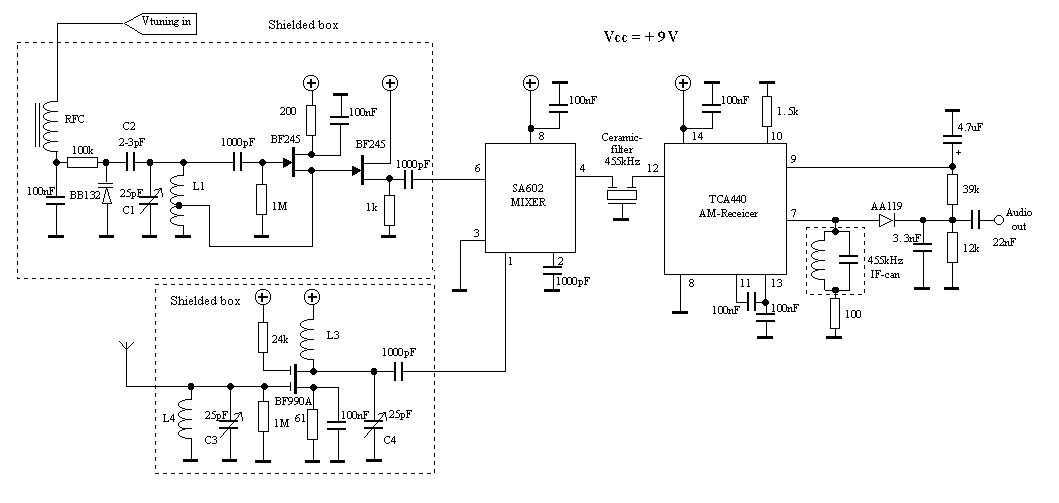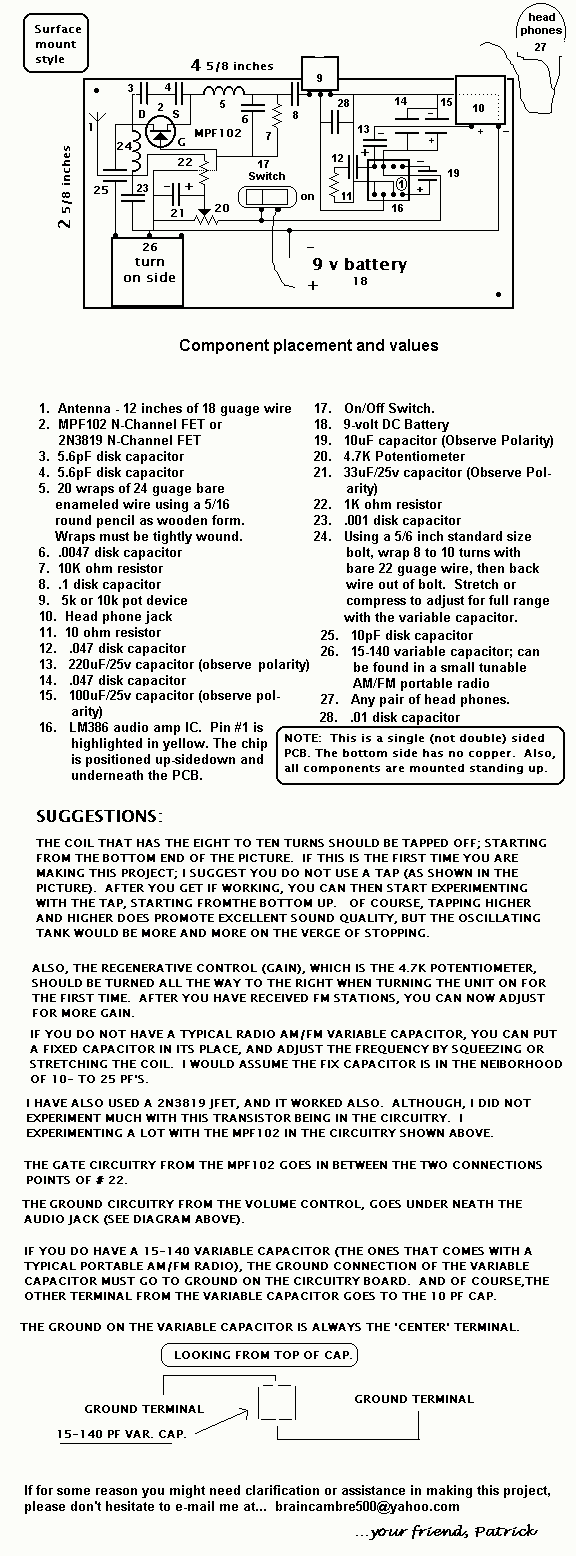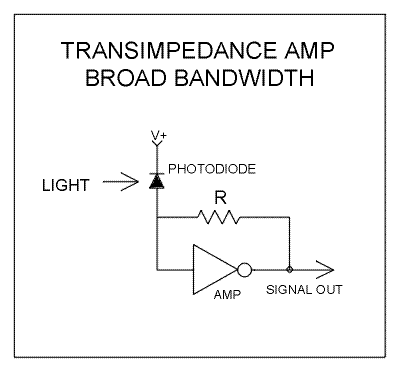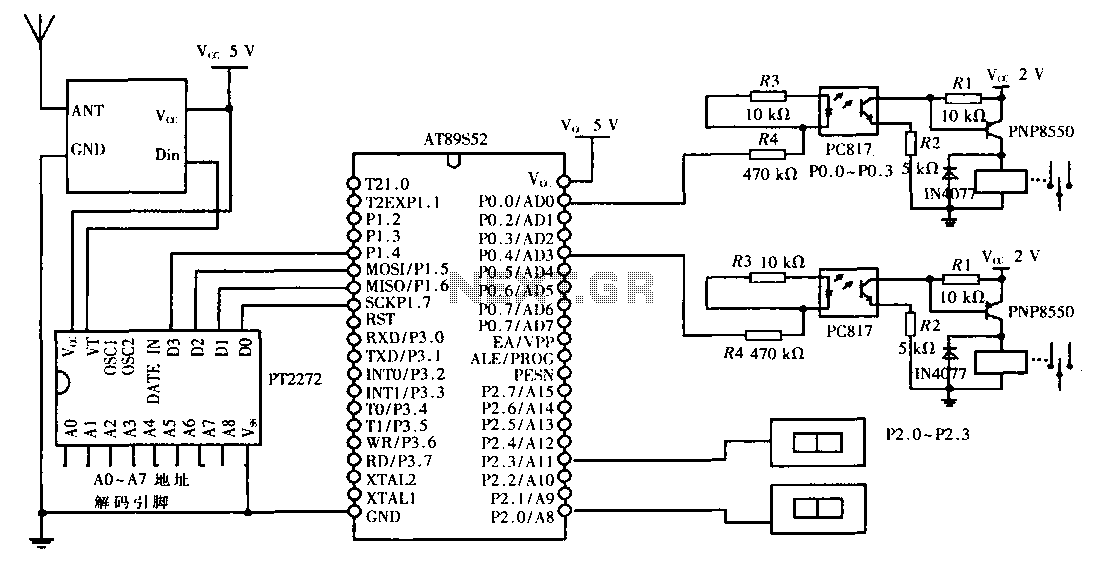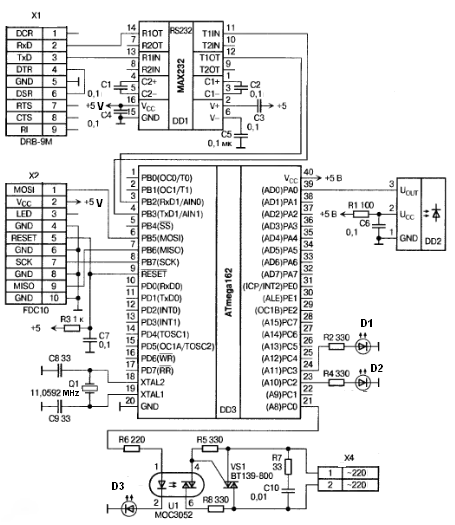
propeller receiver

A straightforward direct conversion receiver utilizes the NE602 Gilbert Cell mixer and an LM386 audio amplifier. This circuit is inspired by the well-known sudden receiver design from Rev. George Dobbs, G3RJV. The implementation omits the tuned circuit components connected to pins 6 and 7 of the NE612 (NE602 in this setup) and directly injects the RF signal generated by the propeller through a blocking capacitor into pin 6 to establish the receive frequency. However, operating at RF frequencies poses several challenges, particularly when components are hastily assembled on protoboards. For instance, the RF pin had to be positioned away from the encoder pins to avoid interference with the encoder code, which was causing frequency fluctuations. Additionally, the audio output from the receiver was affected by noise from the LCD controller chip. Despite these issues, the proof-of-concept implementation has been successful. Future plans include developing a complete, simple all-band transceiver that uses a propeller as both the controller and the RF generation component for the transmitter oscillator and the local oscillator for the receiver.
The circuit design features a NE602 mixer, which is a double-balanced mixer that operates effectively for direct conversion applications. The NE602 is capable of receiving RF signals and converting them to audio frequencies, making it suitable for this application. The LM386 audio amplifier is employed to amplify the audio output from the mixer, providing sufficient volume for listening.
In this configuration, the RF signal generated by the propeller is coupled into the NE602 via a blocking capacitor, which prevents DC voltage from affecting the RF signal while allowing AC signals to pass. The choice of using a blocking capacitor is crucial as it ensures that only the desired RF frequency is injected into the mixer, facilitating proper frequency conversion.
Challenges encountered during the assembly and testing of the circuit include managing unwanted interference and noise. The positioning of components on protoboards can lead to unintended coupling and noise pickup, particularly at RF frequencies. To mitigate this, careful layout and grounding practices should be employed, including minimizing the length of RF signal paths and ensuring that sensitive components are shielded from noise sources.
The success of this proof-of-concept circuit serves as a foundation for the development of a more comprehensive all-band transceiver. This future design will integrate the propeller not only as a controller but also as an RF generation source for both the transmitter and receiver sections, enhancing functionality and performance. The evolution of this project highlights the potential for innovative applications in amateur radio and RF communications, leveraging modern microcontroller capabilities in traditional analog circuits.A very simple direct conversion receiver based on the NE602 Gilbert Cell mixer and a LM386 audio amplifier. The circuit is based onthe famoussudden receiver design from the Rev George Dobbs G3RJV many years ago and looks something like this: My implementation removes all the tuned circuit stuff from pins 6 and 7 of the NE612 (NE602 in my circuit) and injects the RF
generated by the propeller via a blocking capacitor directly into pin 6 to set the receive frequency. Now as you might well imagine, there are a number of problems with playing at RF frequencies with bits of wire lashing all the bits and pieces together stuck into protoboards.
For example, I had to move the RF pin as far from the encoder pins as I could in order to not confuse the encoder code. The frequency kept changing on its own until I turned off the RF. There is a fair amount of "hash" in the receiver audio being generated by the LCD controller chip. But as far as a proof-of-concept impelementation, I could not be happier. With this success, I plan to put together a complete(simple)all-band transceiver using a propeller as the controller as well as RF generation component for both the transmitter oscillator as well as the local oscillator for the receiver.
🔗 External reference
The circuit design features a NE602 mixer, which is a double-balanced mixer that operates effectively for direct conversion applications. The NE602 is capable of receiving RF signals and converting them to audio frequencies, making it suitable for this application. The LM386 audio amplifier is employed to amplify the audio output from the mixer, providing sufficient volume for listening.
In this configuration, the RF signal generated by the propeller is coupled into the NE602 via a blocking capacitor, which prevents DC voltage from affecting the RF signal while allowing AC signals to pass. The choice of using a blocking capacitor is crucial as it ensures that only the desired RF frequency is injected into the mixer, facilitating proper frequency conversion.
Challenges encountered during the assembly and testing of the circuit include managing unwanted interference and noise. The positioning of components on protoboards can lead to unintended coupling and noise pickup, particularly at RF frequencies. To mitigate this, careful layout and grounding practices should be employed, including minimizing the length of RF signal paths and ensuring that sensitive components are shielded from noise sources.
The success of this proof-of-concept circuit serves as a foundation for the development of a more comprehensive all-band transceiver. This future design will integrate the propeller not only as a controller but also as an RF generation source for both the transmitter and receiver sections, enhancing functionality and performance. The evolution of this project highlights the potential for innovative applications in amateur radio and RF communications, leveraging modern microcontroller capabilities in traditional analog circuits.A very simple direct conversion receiver based on the NE602 Gilbert Cell mixer and a LM386 audio amplifier. The circuit is based onthe famoussudden receiver design from the Rev George Dobbs G3RJV many years ago and looks something like this: My implementation removes all the tuned circuit stuff from pins 6 and 7 of the NE612 (NE602 in my circuit) and injects the RF
generated by the propeller via a blocking capacitor directly into pin 6 to set the receive frequency. Now as you might well imagine, there are a number of problems with playing at RF frequencies with bits of wire lashing all the bits and pieces together stuck into protoboards.
For example, I had to move the RF pin as far from the encoder pins as I could in order to not confuse the encoder code. The frequency kept changing on its own until I turned off the RF. There is a fair amount of "hash" in the receiver audio being generated by the LCD controller chip. But as far as a proof-of-concept impelementation, I could not be happier. With this success, I plan to put together a complete(simple)all-band transceiver using a propeller as the controller as well as RF generation component for both the transmitter oscillator as well as the local oscillator for the receiver.
🔗 External reference
